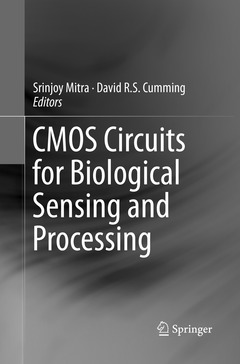Description
CMOS Circuits for Biological Sensing and Processing, Softcover reprint of the original 1st ed. 2018
Language: English
Subject for CMOS Circuits for Biological Sensing and Processing:
Publication date: 05-2018
Support: Print on demand
Publication date: 11-2017
Support: Print on demand
Description
/li>Contents
/li>Biography
/li>Comment
/li>
This book provides the most comprehensive and consistent survey of the field of IC design for Biological Sensing and Processing. The authors describe a multitude of applications that require custom CMOS IC design and highlight the techniques in analog and mixed-signal circuit design that potentially can cross boundaries and benefit the very wide community of bio-medical engineers.
CMOS nano-pore technology.- Metabolomics on CMOS Personalised Medicine.- Flexible Single-Photon Image Sensors.- Photonic interaction with the nervous system.- Microelectronics for muscle fatigue monitoring through surface EMG.- IC Design for high-density Neural probe.- Implantable Microsystems for Personalised Anti-Cancer Therapy.- Compressed Sensing for Neural Recording compression and analysis.- Design optimization for wearable EEG sensors.- CMOS multimodal sensor array for biomedical sensing.- Micro-NMR on CMOS for biomolecular sensing.- Circuits and Systems for Biosensing with Microultrasound.- Very Large scale neuromorphic systems for biological signal processing.- Index.
Srinjoy Mitra is a lecturer at the University of Glasgow. He received his Ph.D. from the Institute of Neuroinformatics, ETH, Zurich in 2004. Until early 2016, he was part of the medical electronics division at IMEC, Belgium, and led multiple projects on wearable and implantable electronics. His primary research interest is in designing novel mixed-signal CMOS circuits for advancement in medical and neural electronics.
David Cumming, FRSE, FREng, FIEEE, is the Head of the School of Engineering at the University of Glasgow. He holds a PhD in microelectronics from the University of Cambridge and leads the Microsystem Technology Group in Glasgow where he has pioneered a range of CMOS based sensor technologies including chemical sensing arrays using ion sensitive field effect transistors and the integration of nanophotonic technologies for imaging applications.

